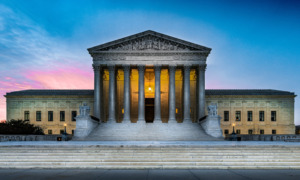Foundations Fight Law To Give More
Some of the nation’s largest foundations are trying to change a provision in a federal charity proposal that would force them to increase their annual contributions.
The Charitable Giving Act (HR7) would modify an existing law that requires private foundations to pay out at least 5 percent of their assets annually to charity. The bill would eliminate a provision that allows foundations to include their general overhead costs when calculating their 5 percent contributions.
The National Committee for Responsive Philanthropy (NCRP) estimated that the provision could send an additional $4.3 billion annually to charities.
“That will make an enormous difference in … communities throughout the nation,” U.S. Rep. Harold Ford (D-Tenn.), the chief Democratic sponsor of the bill, said in a prepared statement.
Several foundations – including the Robert Wood Johnson, Ford, and William and Flora Hewlett foundations – have hired former Rep. Bill Paxon, a Republican from New York, to lobby against the bill. Calls to Paxon, a lobbyist with Akin, Gump, Strauss, Hauer & Feld in Washington, were not returned.
Paxon has his work cut out for him. A spokesman for the bill’s primary Republican sponsor, House majority whip Roy Blunt of Missouri, said his boss has not changed his position.
“Congressman Blunt feels it’s a good provision and will help a lot of people, and needs to be in there,” said Blunt’s deputy press secretary, Laurent Crenshaw. “Helping foundations to give more is a good thing.”
A spokesman for Rep. Ford agreed. “Pretty much all the academic literature says there’s some room” for foundations to abide by the proposal without suffering economic problems, spokesman Seth Hanlon said.
Foundations and organizations opposed to the provision – like the Council on Foundations, Independent Sector and the American Society of Association Executives – question that conclusion. The Foundation Center recently completed a review of the NCRP’s analysis of the legislation’s impact, and reported that the rule change would increase grant making by “well under” the $4.3 billion estimate.
Foundations also worry about their ability to exist in perpetuity if their expenses increase.
“If you eliminate administrative expenses” as part of the payout requirement, “you are increasing payout,” said Kevin Anderson, director of government relations and public policy at the Council on Foundations (CoF), based in Washington.
Administrative expenses average about 0.5 percent of a foundation’s assets, according to several associations, meaning a foundation would have to spend at least 5.5 percent of its assets a year. If an annual inflation rate of 4 percent is added foundations would need to earn at least 9.5 percent on their assets annually to stay financially level.
In its analysis, the NCRP estimated that foundations average a return of 7.62 percent.
(Although inflation was about 2.4 percent for 2002, according to the U.S. Department of Labor, the CoF’s 4 percent figure represents the average since 1950.)
Even foundations and organizations that have not staked out clear positions on the provision are worried about its potential impact. “We believe that including such provision in the Charitable Giving Act of 2003 is premature,” said a statement by the National Council of Nonprofit Associations.
Lawmakers who favor the provision said it could make foundations consider their expenses more carefully. They note that until a change in the law in 1981, foundations had to pay out 6 percent annually.
If the House approves the measure with the provision intact, the bill would have to be reconciled with a Senate bill (S 476) that does not contain that provision. The Senate passed its version 95-5 in April.
The House and Senate bills would also encourage greater charitable giving by allowing $250 deductions for taxpayers who do not itemize their returns; allow seniors over 70 years old to contribute their retirement accounts to charities tax-free; and reauthorize a program that helps low-income people establish savings accounts.
Contact: National Center for Responsive Philanthropy, (202) 387-9177, www.ncrp.org; Council on Foundations, (202) 466-6512, www.cof.org.
Being Poor Costs Too Much, Casey Says
The well-being of the nation’s children improved in the 1990s, but trouble looms and the country needs to focus on the “high cost of being poor,” the Annie E. Casey Foundation (AECF) said last month.
The 14th edition of the foundation’s annual Kids Count Data Book – which examines indicators such as teen birth rates and child death rates for each state – compares data from 1990 and 2000 to show decade-long trends. Minnesota, New Hampshire and Utah earned the top three rankings for the year 2000, while Alabama, Louisiana and Mississippi rounded out the bottom.
Among the findings from the decade-long comparison:
• The national child poverty rate has decreased 15 percent. Even with that improvement, 17 percent of American children were in poverty in 2000.
• Overall, states improved in eight of the 10 indicators.
• The number of families headed by a single parent increased 17 percent.
Foundation President Douglas Nelson said the improvements were due in large part to the economic boom of the 1990s. “The general well-being of children depends heavily on the economic well-being of their parents,” Nelson said.
That was demonstrated by the high ranking of Minnesota, where only 16 percent of parents lack full-time employment, and the low ranking of Mississippi, where 27 percent of parents do not work full-time.
The economic link spells potential trouble for the future, foundation officials said, because of the poor economy. Low-income families are disproportionately affected by everyday costs, which Nelson referred to as “the high cost of being poor.”
“Inner-city parents may pay 20 percent more for a basket of groceries, or two to three times more for a car loan, adding additional strain to financial resources,” he said.
Larry Aber – director of the National Center for Children in Poverty, who joined a panel to discuss the report when it was released in Washington, D.C. – said job-related tax breaks and improved benefits packages for low-wage earners would help alleviate the burden of poor families.
Panelists also suggested that retailers and banks do more to cater to inner-city families. Gloria Guerrero of the Rural Development and Finance Corp. in San Antonio, Texas, said banks and credit card companies need “a standard way of reporting positive credit” histories so that companies have more incentive for offering loans to low-income parents.
The Kids Count Data Book is available free by calling (410) 547-6600, and is on the web at www.aecf.org/publications.
Web Filters OK, Supreme Court Says
The U.S. Supreme Court last month upheld the Child Internet Protection Act, which requires public libraries across the nation to install filtering software to block pornography. The American Library Association (ALA), which said the “very narrow ruling” violates the First Amendment, expressed “extreme disappointment” with the 6-3 decision.
Provisions of the CIPA require all libraries that receive federal funding for Internet technology to install software that blocks access to websites that might be considered obscene and inappropriate for children. The court has supported broader interpretations of the First Amendment’s reach, but said filters do not violate the right to free speech as defined in the constitution.
The Bush administration supports the act, arguing that filters are the most efficient way available to guard children from obscene materials online. About 95 percent of libraries nationwide offer Web access, and roughly 76 percent of library patrons, including children, use the Internet, according to the ALA.
The ALA and other opponents of the act said filters block some nonpornographic as well as pornographic websites and therefore limit the public’s access to some general Internet resources. Web pages about sex education, for example, could be filtered out, even though the First Amendment protects such sites.
The association said that parents and guardians, not the manufacturers of computer-filtering software, should decide what is appropriate for children to view.
Contact: ALA, www.ala.org.
Briefly…
Violent Video Games: Washington became the first state to ban the rental and sale of certain video games to minors. As of July 27, vendors face a $500 fine for selling or renting games to someone under 17 that depict murder or injuring “a human form.” Other states, counties and cities have tried similar laws, only to have them knocked down as unconstitutional. Challenges to this law are almost certain, but state Rep. Mary Lou Dickerson (D) is confident the law will be upheld because it is more narrowly tailored than its predecessors. Courts have already ruled that the First Amendment bans the regulation of more traditional forms of media, such as books and movies.
Sex Offenders Exiled? Eighty percent of child sex offenders in Wisconsin would have to move if a bill in the state legislature passes, according to an analysis by the state Department of Corrections. The law would require convicted child molesters, including those who have finished their sentences, to live more than 1,000 feet away from many facilities, including schools, parks and housing projects. Such restrictions would make it impossible to live in urban areas, which would lead to the exodus of 2,500 offenders to rural areas over the next five years, according to Cathy Halpin of the Department of Corrections. One proposed solution is the construction of multi-unit housing in rural areas for the offenders.
Sweet 16: Brides and grooms in Alabama now must be at least 16 years old, under a law passed by the state House and Senate last month. Teens had been able to marry at 14, with parental consent. Gov. Bob Riley (R) said teens from neighboring states and their families had been coming to Alabama to take advantage of the low minimum age. Alabama’s marriage age requirement will now be the same as in most Southern states.
Hispanic Dropout Rate: Two new studies make different claims about enrollment and dropout rates for Hispanic students. “Hispanic Youth Dropping Out of U.S. Schools: Measuring the Challenge,” by the Pew Hispanic Center, found that while researchers often estimate that 30 percent of Hispanic youth drop out of school, the rate drops to about 15 percent when immigrant youth with little or no contact with U.S. schools are excluded. www.pewhispanic.org.
“Status and Trends in the Education of Hispanics,” the National Center for Education Statistics study that serves as the backbone of the Pew report, attributes most of the recent rise in minority enrollment in elementary and secondary school to Hispanic youth. The bad news, says the report: The Hispanic dropout rate is still higher than those of black and white youth, and the income average for Hispanics at almost every educational level remains well below that of whites. http://nces.ed.gov/pubs2003/hispanics.
Promising Models: America’s Promise has selected 13 community programs affiliated with the national organization to serve as demonstration sites because of their success in developing local collaborations to serve children. Each site will be studied and used as a model for other communities to establish or improve youth-serving programs. The national organization said it will devote nearly one-fourth of its staff to the demonstration projects, spending about $500,000 per community, none of it through direct grants.
Income Tax for Schools: Oregon voters recently passed the state’s only county income tax, generating revenue for schools, law enforcement and other services. In Multnomah County, which includes Portland, 58 percent of voters approved a temporary tax projected to raise at least $128 million over three years. From that, Portland and seven smaller school districts are expected to receive about $89 million.

























